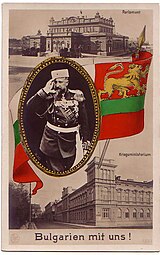| This article needs additional citations for verification. Please help improve this article by adding citations to reliable sources. Unsourced material may be challenged and removed. Find sources: "Battle of Florina" – news · newspapers · books · scholar · JSTOR (June 2016) (Learn how and when to remove this message) |
| Battle of Florina | |||||||
|---|---|---|---|---|---|---|---|
| Part of Macedonian front (World War I) | |||||||
 Battle of Lerin (to the south-west) | |||||||
| |||||||
| Belligerents | |||||||
|
|
| ||||||
| Commanders and leaders | |||||||
|
|
| ||||||
| Units involved | |||||||
|
|
| ||||||
| Strength | |||||||
| 124,000 | ||||||
| Casualties and losses | |||||||
|
| ||||||
| Macedonian front | |
|---|---|
The Battle of Lerin or Battle of Florina or Chegan offensive was an offensive operation of the Bulgarian army fought between 17–28 August 1916, during the First World War, in which they conquered the city of Florina (in present-day Greece, but known in Bulgaria as Lerin) but failed to take Chegan.
Background
In August 1916, Romania chose to join the war effort on the side of the Entente. The Allies planned a large offensive in the Macedonian front for the middle of August to support Romania's entry into the war and pin down as many Bulgarian forces as possible. The Bulgarian high command suspected an impending offensive, and the fighting around Doiran that erupted on 9 August only confirmed these suspicions. On their part, the Bulgarians had urged for an offensive in Macedonia since the beginning of the year, now planning a strike with the First Army and Second Army on both Allied flanks.
The Struma operation on the eastern flank by the Bulgarian Second Army under General Todorov was a huge success, mainly because the Greek government ordered their troops not to resist.
Chegan operation
The advance on the right flank was to be undertaken by the Bulgarian First Army, which had the following order of battle in July 1916:
| Battalions | Men | Rifles | Machine guns | Cannons | |
|---|---|---|---|---|---|
| Army Staff, rear services etc. | 13,361 | 5,524 | |||
| Eighth "Tundzha" Infantry Division | 22 | 41,376 | 22,538 | 36 | 48 |
| 3/6 Infantry Brigade | 10 | 8,029 | 6,491 | 12 | 12 |
| Third Cavalry Brigade | 1,892 | 1,310 | 4 | ||
| Third "Balkan" Infantry Division | 21 | 42,777 | 26,953 | 36 | 48 |
| Army Units (15th IR, reserves etc.) | 4 | 7,946 | 7,000 | 20 | 66 |
| German Units | 1,987 | 987 | 24 | 12 | |
| Total | 57 | 117,368 | 70,803 | 128 | 190 |
The Germans finally agreed that an offensive was needed, and on 12 August general Boyadzhiev received his orders from the headquarters of Army Group "Mackensen". The right wing of the army, consisting of the reinforced 8th infantry division (four and a half infantry brigades,) was to advance and take Lerin while parts of the 3rd division towards the Chegan mountain range and the village of the same name (today known as Agios Athanasios, to the north-west of Lake Vegoritida, in the Greek regional unit of Pella). General Boyadzhiev agreed to attack but had concerns regarding the final results of the offensive because his army was scattered on a 140 km front and lacked enough mountain and heavy artillery. The six infantry and one cavalry divisions of the three Serbian armies faced the Bulgarians.
The offensive began on 17 August 1916, with the Bulgarians taking Lerin and Banitsa. However, the advance soon encountered difficulties, slowing down considerably due to the increased Serbian resistance. The fighting was especially heavy on the bare rocky slopes of Chegan Mountain and the Voras Mountains. The Serbians were reinforced with new artillery constantly and fresh troops thanks to the railway that reached the battlefield, while the Bulgarians soon began depleting their ammunition stocks. This and the slow advance forced the Bulgarian high command to call off all attacks on 27 August and order the forces to dig in on the occupied positions between Lake Vegoritida, Lake Petron and along the ridges of the Voras Mountains. For the next several days, the Bulgarian positions were subjected to heavy artillery fire and a few Serbian attacks that were repulsed.
Consequences
The Chegan Offensive also known as the Lerin Offensive had failed. It failed to influence Romania, which entered the war on the side of the Allies but also failed to achieve its final military objective to take the Chegan village and the pass north of Lake Ostrovo.
French General Maurice Sarrail now prepared a counterattack against the First Bulgarian Army that would eventually develop in the Monastir Offensive. The French retook Lerin/Florina on 23 September 1916.
Footnotes
- These units were labelled as field armies, but were, in fact, corps-sized formations
References
Sources
- Falls, Cyril Bentham (1933). Military Operations Macedonia. From the Outbreak of War to the Spring of 1917. History of the Great War based on Official Documents. London: His Majesty’s Stationery Office.
See also
| Wars and battles involving Serbs | |||||||||||||||||
|---|---|---|---|---|---|---|---|---|---|---|---|---|---|---|---|---|---|
| Medieval |
| ||||||||||||||||
| Foreign rule |
| ||||||||||||||||
| 19th century |
| ||||||||||||||||
| 20th century |
| ||||||||||||||||
| 21st century |
| ||||||||||||||||
40°47′00″N 21°24′00″E / 40.7833°N 21.4000°E / 40.7833; 21.4000
Categories:
